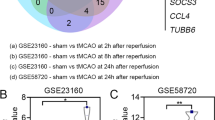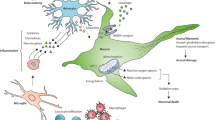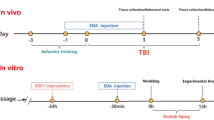Abstract
Perioperative neurocognitive disorder (PND) is a common complication of surgery and anesthesia, especially among older patients. Microglial activation plays a crucial role in the occurrence and development of PND and transforming growth factor beta 1 (TGF-β1) can regulate microglial homeostasis. In the present study, abdominal surgery was performed on 12–14 months-old C57BL/6 mice to establish a PND model. The expression of TGF-β1, TGF-β receptor 1, TGF-β receptor 2, and phosphor-smad2/smad3 (psmad2/smad3) was assessed after anesthesia and surgery. Additionally, we examined changes in microglial activation, morphology, and polarization, as well as neuroinflammation and dendritic spine density in the hippocampus. Behavioral tests, including the Morris water maze and open field tests, were used to examine cognitive function, exploratory locomotion, and emotions. We observed decreased TGF-β1 expression after surgery and anesthesia. Intranasally administered exogenous TGF-β1 increased psmad2/smad3 colocalization with microglia positive for ionized calcium-binding adaptor molecule 1. TGF-β1 treatment attenuated microglial activation, reduced microglial phagocytosis, and reduced surgery- and anesthesia-induced changes in microglial morphology. Compared with the surgery group, TGF-β1 treatment decreased M1 microglial polarization and increased M2 microglial polarization. Additionally, surgery- and anesthesia-induced increase in interleukin 1 beta and tumor necrosis factor-alpha levels was ameliorated by TGF-β1 treatment at postoperative day 3. TGF-β1 also ameliorated cognitive function after surgery and anesthesia as well as rescue dendritic spine loss. In conclusion, surgery and anesthesia induced decrease in TGF-β1 levels in older mice, which may contribute to PND development; however, TGF-β1 ameliorated microglial activation and cognitive dysfunction in PND mice.






Similar content being viewed by others
Data Availability
The datasets used and/or analyzed in the present study are available from the corresponding author upon reasonable request.
References
Jin Z, Hu J, Ma D (2020) Postoperative delirium: perioperative assessment, risk reduction, and management. Br J Anaesth 125:492–504. https://doi.org/10.1016/j.bja.2020.06.063
Needham MJ, Webb CE, Bryden DC (2017) Postoperative cognitive dysfunction and dementia: what we need to know and do. Br J Anaesth 119:i115–i125. https://doi.org/10.1093/bja/aex354
Feng X, Valdearcos M, Uchida Y, Lutrin D, Maze M, Koliwad SK (2017) Microglia mediate postoperative hippocampal inflammation and cognitive decline in mice. JCI insight 2:e91229. https://doi.org/10.1172/jci.insight.91229
Subramaniyan S, Terrando N (2019) Neuroinflammation and perioperative neurocognitive disorders. Anesth Analg 128:781–788. https://doi.org/10.1213/ane.0000000000004053
Deczkowska A, Keren-Shaul H, Weiner A, Colonna M, Schwartz M, Amit I (2018) Disease-associated microglia: a universal immune sensor of neurodegeneration. Cell 173:1073–1081. https://doi.org/10.1016/j.cell.2018.05.003
Guo L, Choi S, Bikkannavar P, Cordeiro MF (2022) Microglia: key players in retinal ageing and neurodegeneration. Front Cell Neurosci 16:804782. https://doi.org/10.3389/fncel.2022.804782
Salter MW, Stevens B (2017) Microglia emerge as central players in brain disease. Nat Med 23:1018–1027. https://doi.org/10.1038/nm.4397
Sun Y, Wang Y, Ye F, Cui V, Lin D, Shi H, Zhang Y, Wu A, Wei C (2022) SIRT1 activation attenuates microglia-mediated synaptic engulfment in postoperative cognitive dysfunction. Front Aging Neurosci 14:943842. https://doi.org/10.3389/fnagi.2022.943842
Guo S, Wang H, Yin Y (2022) Microglia polarization from M1 to M2 in neurodegenerative diseases. Front Aging Neurosci 14:815347. https://doi.org/10.3389/fnagi.2022.815347
Liu Y, Yin Y (2018) Emerging roles of immune cells in postoperative cognitive dysfunction. https://doi.org/10.1155/2018/6215350. mediators inflamm 2018:6215350
Safavynia SA, Goldstein PA (2018) The role of neuroinflammation in postoperative cognitive dysfunction: moving from hypothesis to treatment. Front Psychiatry 9:752. https://doi.org/10.3389/fpsyt.2018.00752
Zhang X, Huang WJ, Chen WW (2016) TGF-β1 factor in the cerebrovascular diseases of Alzheimer’s disease. Eur Rev Med Pharmacol Sci 20:5178–5185
Caraci F, Battaglia G, Bruno V, Bosco P, Carbonaro V, Giuffrida ML, Drago F, Sortino MA, Nicoletti F, Copani A (2011) TGF-β1 pathway as a new target for neuroprotection in Alzheimer’s disease. CNS Neurosci Ther 17:237–249. https://doi.org/10.1111/j.1755-5949.2009.00115.x
Spittau B, Dokalis N, Prinz M (2020) The role of TGFβ signaling in microglia maturation and activation. Trends Immunol 41:836–848. https://doi.org/10.1016/j.it.2020.07.003
Olah M, Patrick E, Villani AC, Xu J, White CC, Ryan KJ, Piehowski P, Kapasi A, Nejad P, Cimpean M, Connor S, Yung CJ, Frangieh M, McHenry A, Elyaman W, Petyuk V, Schneider JA, Bennett DA, De Jager PL, Bradshaw EM (2018) A transcriptomic atlas of aged human microglia. Nat Commun 9:539. https://doi.org/10.1038/s41467-018-02926-5
Norden DM, Fenn AM, Dugan A, Godbout JP (2014) TGFβ produced by IL-10 redirected astrocytes attenuates microglial activation. Glia 62:881–895. https://doi.org/10.1002/glia.22647
Buttgereit A, Lelios I, Yu X, Vrohlings M, Krakoski NR, Gautier EL, Nishinakamura R, Becher B, Greter M (2016) Sall1 is a transcriptional regulator defining microglia identity and function. Nat Immunol 17:1397–1406. https://doi.org/10.1002/glia.22647
Zöller T, Schneider A, Kleimeyer C, Masuda T, Potru PS, Pfeifer D, Blank T, Prinz M, Spittau B (2018) Silencing of TGFβ signalling in microglia results in impaired homeostasis. Nat Commun 9:4011. https://doi.org/10.1038/s41467-018-06224-y
Abutbul S, Shapiro J, Szaingurten-Solodkin I, Levy N, Carmy Y, Baron R, Jung S, Monsonego A (2012) TGF-β signaling through SMAD2/3 induces the quiescent microglial phenotype within the CNS environment. Glia 60:1160–1171. https://doi.org/10.1002/glia.22343
Luo T, Lin D, Hao Y, Shi R, Wei C, Shen W, Wu A, Huang P (2021) Ginkgolide B–mediated therapeutic effects on perioperative neurocognitive dysfunction are associated with the inhibition of iNOS–mediated production of NO. Mol Med Rep 24. https://doi.org/10.3892/mmr.2021.12176
Zhang K, Yang C, Chang L, Sakamoto A, Suzuki T, Fujita Y, Qu Y, Wang S, Pu Y, Tan Y, Wang X, Ishima T, Shirayama Y, Hatano M, Tanaka KF, Hashimoto K (2020) Essential role of microglial transforming growth factor-β1 in antidepressant actions of (R)-ketamine and the novel antidepressant TGF-β1. Transl Psychiatry 10:32. https://doi.org/10.1038/s41398-020-0733-x
Vorhees CV, Williams MT (2006) Morris water maze: procedures for assessing spatial and related forms of learning and memory. Nat Protoc 1:848–858. https://doi.org/10.1038/nprot.2006.116
Kraeuter AK, Guest PC, Sarnyai Z (2019) The open field test for measuring locomotor activity and anxiety-like behavior. Methods Mol Biol 1916:99–103. https://doi.org/10.1007/978-1-4939-8994-2_9
Schafer DP, Lehrman EK, Heller CT, Stevens B (2014) An engulfment assay: a protocol to assess interactions between CNS phagocytes and neurons. J Vis Exp. https://doi.org/10.3791/51482
Young K, Morrison H (2018) Quantifying microglia morphology from photomicrographs of immunohistochemistry prepared tissue using ImageJ. J Vis Exp. https://doi.org/10.3791/57648
Wang R, Palavicini JP, Wang H, Maiti P, Bianchi E, Xu S, Lloyd BN, Dawson-Scully K, Kang DE, Lakshmana MK (2014) RanBP9 overexpression accelerates loss of dendritic spines in a mouse model of Alzheimer’s disease. Neurobiol Dis 69:169–179. https://doi.org/10.1016/j.nbd.2014.05.029
Butovsky O, Jedrychowski MP, Moore CS, Cialic R, Lanser AJ, Gabriely G, Koeglsperger T, Dake B, Wu PM, Doykan CE, Fanek Z, Liu L, Chen Z, Rothstein JD, Ransohoff RM, Gygi SP, Antel JP, Weiner HL (2014) Identification of a unique TGF-β-dependent molecular and functional signature in microglia. Nat Neurosci 17:131–143. https://doi.org/10.1038/nn.3599
Spittau B, Wullkopf L, Zhou X, Rilka J, Pfeifer D, Krieglstein K (2013) Endogenous transforming growth factor-beta promotes quiescence of primary microglia in vitro. Glia 61:287–300. https://doi.org/10.1002/glia.22435
Islam A, Choudhury ME, Kigami Y, Utsunomiya R, Matsumoto S, Watanabe H, Kumon Y, Kunieda T, Yano H, Tanaka J (2018) Sustained anti-inflammatory effects of TGF-β1 on microglia/macrophages. Biochim Biophys Acta Mol Basis Dis 1864:721–734. https://doi.org/10.1016/j.bbadis.2017.12.022
Zhang ZJ, Zheng XX, Zhang XY, Zhang Y, Huang BY, Luo T (2020) Aging alters Hv1-mediated microglial polarization and enhances neuroinflammation after peripheral surgery. CNS Neurosci Ther 26:374–384. https://doi.org/10.1111/cns.13271
Andoh M, Koyama R (2021) Microglia regulate synaptic development and plasticity. Dev Neurobiol 81:568–590. https://doi.org/10.1002/dneu.22814
Krukowski K, Chou A, Feng X, Tiret B, Paladini MS, Riparip LK, Chaumeil MM, Lemere C, Rosi S (2018) Traumatic brain injury in aged mice induces chronic microglia activation, synapse loss, and complement-dependent memory deficits. Int J Mol Sci 19. https://doi.org/10.3390/ijms19123753
Zhao J, Wang B, Wu X, Yang Z, Huang T, Guo X, Guo D, Liu Z, Song J (2020) TGFβ1 alleviates axonal injury by regulating microglia/macrophages alternative activation in traumatic brain injury. Brain Res Bull 161:21–32. https://doi.org/10.1016/j.brainresbull.2020.04.011
Taylor RA, Chang CF, Goods BA, Hammond MD, Mac Grory B, Ai Y, Steinschneider AF, Renfroe SC, Askenase MH, McCullough LD, Kasner SE, Mullen MT, Hafler DA, Love JC, Sansing LH (2017) TGF-β1 modulates microglial phenotype and promotes recovery after intracerebral hemorrhage. J Clin Invest 127:280–292. https://doi.org/10.1172/jci88647
Sun ZZ, Li YF, Xv ZP, Zhang YZ, Mi WD (2020) Bone marrow mesenchymal stem cells regulate TGF-β to adjust neuroinflammation in postoperative central inflammatory mice. J Cell Biochem 121:371–384. https://doi.org/10.1002/jcb.29188
Patel RK, Prasad N, Kuwar R, Haldar D, Abdul-Muneer PM (2017) Transforming growth factor-beta 1 signaling regulates neuroinflammation and apoptosis in mild traumatic brain injury. Brain Behav Immun 64:244–258. https://doi.org/10.1016/j.bbi.2017.04.012
Tichauer JE, Flores B, Soler B, Eugenín-von Bernhardi L, Ramírez G, von Bernhardi R (2014) Age-dependent changes on TGFβ1 Smad3 pathway modify the pattern of microglial cell activation. Brain Behav Immun 37:187–196. https://doi.org/10.1016/j.bbi.2013.12.018
Yu Y, Li J, Zhou H, Xiong Y, Wen Y, Li H (2018) Functional importance of the TGF-β1/Smad3 signaling pathway in oxygen-glucose-deprived (OGD) microglia and rats with cerebral ischemia. Int J Biol Macromol 116:537–544. https://doi.org/10.1016/j.ijbiomac.2018.04.113
Zhang L, Wei W, Ai X, Kilic E, Hermann DM, Venkataramani V, Bähr M, Doeppner TR (2021) Extracellular vesicles from hypoxia-preconditioned microglia promote angiogenesis and repress apoptosis in stroke mice via the TGF-β/Smad2/3 pathway. Cell Death Dis 12:1068. https://doi.org/10.1038/s41419-021-04363-7
Attaai A, Neidert N, von Ehr A, Potru PS, Zöller T, Spittau B (2018) Postnatal maturation of microglia is associated with alternative activation and activated TGFβ signaling. Glia 66:1695–1708. https://doi.org/10.1002/glia.23332
Walker FR, Beynon SB, Jones KA, Zhao Z, Kongsui R, Cairns M, Nilsson M (2014) Dynamic structural remodelling of microglia in health and disease: a review of the models, the signals and the mechanisms. Brain Behav Immun 37:1–14. https://doi.org/10.1016/j.bbi.2013.12.010
Matsumoto S, Choudhury ME, Takeda H, Sato A, Kihara N, Mikami K, Inoue A, Yano H, Watanabe H, Kumon Y, Kunieda T, Tanaka J (2022) Microglial re-modeling contributes to recovery from ischemic injury of rat brain: a study using a cytokine mixture containing granulocyte-macrophage colony-stimulating factor and interleukin-3. Front Neurosci 16:941363. https://doi.org/10.3389/fnins.2022.941363
Butovsky O, Weiner HL (2018) Microglial signatures and their role in health and disease. Nat Rev Neurosci 19:622–635. https://doi.org/10.1038/s41583-018-0057-5
Hong S, Beja-Glasser VF, Nfonoyim BM, Frouin A, Li S, Ramakrishnan S, Merry KM, Shi Q, Rosenthal A, Barres BA, Lemere CA, Selkoe DJ, Stevens B (2016) Complement and microglia mediate early synapse loss in Alzheimer mouse models. Science 352:712–716. https://doi.org/10.1126/science.aad8373
Xiong C, Liu J, Lin D, Zhang J, Terrando N, Wu A (2018) Complement activation contributes to perioperative neurocognitive disorders in mice. J Neuroinflammation 15:254. https://doi.org/10.1186/s12974-018-1292-4
Shui M, Sun Y, Lin D, Xue Z, Liu J, Wu A, Wei C (2022) Anomalous levels of CD47/Signal Regulatory protein alpha in the hippocampus lead to excess microglial engulfment in mouse model of perioperative neurocognitive disorders. Front Neurosci 16:788675. https://doi.org/10.3389/fnins.2022.788675
Li D, Chen M, Meng T, Fei J (2020) Hippocampal microglial activation triggers a neurotoxic-specific astrocyte response and mediates etomidate-induced long-term synaptic inhibition. J Neuroinflammation 17:109. https://doi.org/10.1186/s12974-020-01799-0
Ma D, Liu J, Wei C, Shen W, Yang Y, Lin D, Wu A (2021) Activation of CD200-CD200R1 axis attenuates perioperative neurocognitive disorder through inhibition of neuroinflammation in mice. Neurochemical Res 46:3190–3199. https://doi.org/10.1007/s11064-021-03422-x
Zhong Y, Gu L, Ye Y, Zhu H, Pu B, Wang J, Li Y, Qiu S, Xiong X, Jian Z (2022) JAK2/STAT3 axis intermediates microglia/macrophage polarization during cerebral ischemia/reperfusion injury. Neuroscience 496:119–128. https://doi.org/10.1016/j.neuroscience.2022.05.016
Huang W, Tao Y, Zhang X, Zhang X (2022) TGF-β1/SMADs signaling involved in alleviating inflammation induced by nanoparticulate titanium dioxide in BV2 cells. Toxicol In Vitro 80:105303. https://doi.org/10.1016/j.tiv.2021.105303
Liu F, Qiu H, Xue M, Zhang S, Zhang X, Xu J, Chen J, Yang Y, Xie J (2019) MSC-secreted TGF-β regulates lipopolysaccharide-stimulated macrophage M2-like polarization via the Akt/FoxO1 pathway. Stem Cell Res Ther 10:345. https://doi.org/10.1186/s13287-019-1447-y
Qiu LL, Pan W, Luo D, Zhang GF, Zhou ZQ, Sun XY, Yang JJ, Ji MH (2020) Dysregulation of BDNF/TrkB signaling mediated by NMDAR/Ca(2+)/calpain might contribute to postoperative cognitive dysfunction in aging mice. J Neuroinflammation 17:23. https://doi.org/10.1186/s12974-019-1695-x
Xie Y, Chen X, Li Y, Chen S, Liu S, Yu Z, Wang W (2022) Transforming growth factor-β1 protects against LPC-induced cognitive deficit by attenuating pyroptosis of microglia via NF-κB/ERK1/2 pathways. J Neuroinflammation 19:194. https://doi.org/10.1186/s12974-022-02557-0
Acknowledgements
We thank the assistance of the State Key Laboratory of Membrane Biology at Peking University in Beijing, China. We thank the assistance from the Central Core Facility of the National Center for Protein Sciences at Peking University, and Dr. Siying Qin at the Core Facilities of the School of Life Sciences, Peking University for assistance with optical/confocal imaging.
Funding
This study was supported by grand no. 82071176 from the National Science Foundation of China (NSFC), Beijing, China, grand no. 7222074 from the Beijing Natural Science Foundation, Beijing, China, and grand no. CYJZ202128 from Beijing Chao-Yang Hospital Golden Seeds Foundation. This study was supported by the NSFC general research grants (81971679), the National of Science and Technology Innovation 2030 (2022ZD0211800), and the Qidong-PKU SLS Innovation Fund (2016000663).
Author information
Authors and Affiliations
Contributions
Study design, C. W, A. W, Z.Y, and D.L; Performed research, D. L, D. Y, S.Y, Y. W; Data analyzed, M. S, Z. X; Writing-Original draft preparation, D. L, D. Y; Writing-review & editing, S.Y, Y. W, C.W, A. W; Supervision, C.W, A. W, Z.Y; Funding acquisition, Y. S, Y. Z, A. W. The final manuscript was approved by all authors.
Corresponding authors
Ethics declarations
Consent for Publication
Not applicable.
Competing interests
The authors declare no competing interests.
Additional information
Publisher’s Note
Springer Nature remains neutral with regard to jurisdictional claims in published maps and institutional affiliations.
Electronic Supplementary Material
Below is the link to the electronic supplementary material.
11064_2023_3994_MOESM1_ESM.docx
Supplementary Fig. 1 TGF-β1 level on postoperative day 1, 3, and 7. (A) Representative images from western blotting of TGF-β1. (B) Quantification of TGF-β1. n = 3. Data are shown as mean ± SEM. *p < 0.05. POD, postoperative day. Supplementary Fig. 2 Lamp1 level on postoperative day 3. (A) Representative images from western blotting of Lamp1 in hippocampus. (B) Quantification of Lamp1. n = 6. Data are shown as mean ± SEM. *p < 0.05; **p < 0.01. Supplementary Fig. 3 CD16/32 and CD206 level on postoperative day 3. (A) Representative images from western blotting of CD16/32 and CD206 in hippocampus. (B) Quantification of CD206. (C) Quantification of CD16/32. n = 6. Data are shown as mean ± SEM. *p < 0.05; **p < 0.01.
Rights and permissions
Springer Nature or its licensor (e.g. a society or other partner) holds exclusive rights to this article under a publishing agreement with the author(s) or other rightsholder(s); author self-archiving of the accepted manuscript version of this article is solely governed by the terms of such publishing agreement and applicable law.
About this article
Cite this article
Lin, D., Sun, Y., Wang, Y. et al. Transforming Growth Factor β1 Ameliorates Microglial Activation in Perioperative Neurocognitive Disorders. Neurochem Res 48, 3512–3524 (2023). https://doi.org/10.1007/s11064-023-03994-w
Received:
Revised:
Accepted:
Published:
Issue Date:
DOI: https://doi.org/10.1007/s11064-023-03994-w




